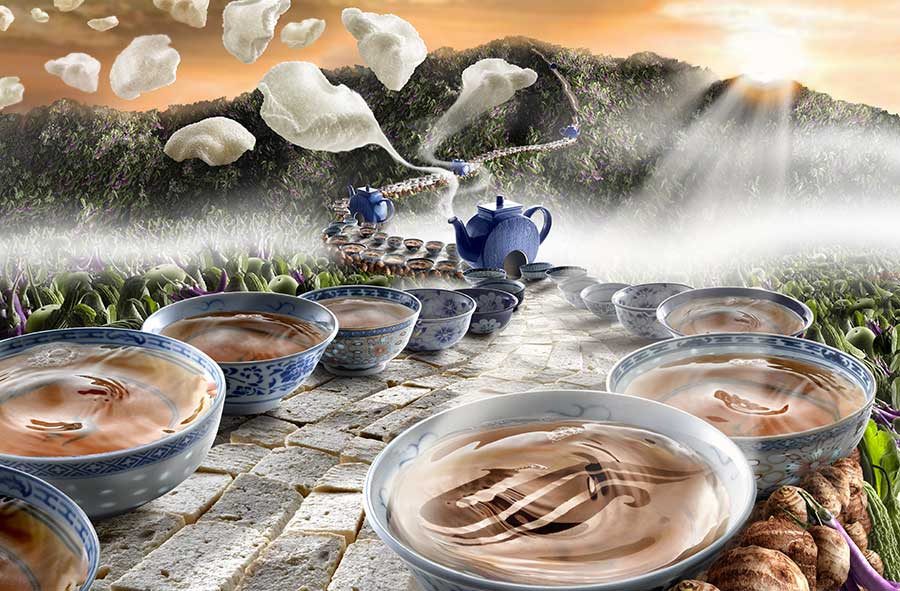Patrizia Piga was born in Torino, Italy. She attended studies related to advertising graphics and meanwhile the university in Foreign Languages. She has 20 years of experience in food photography, gained in Turin’s studio Piga&Catalano, that creates shots especially for major italian food brands’ packaging.
The transition from analo- gue to digital shooting leads her to get especially passionate in post production, which becomes part of her work, and awakens an old passion for drawing and illus- tration. So, in 2015 she decided to launch her first indipendent art project – a series of surreal photos, inspired by the universe of food, which could be described with the term Foodscape. With her working partner Flavio Catalano carries out the project Mystic Light, a series of still lifes inspired by the light and the compositions of the Flemish painters. Both projects participating in exhibitions and publications and are also used for advertising purposes.[Official Website]
Can you explain us the idea or the story behind this image?
This photo was commissioned by Air China and Slow Food China to be part of an installation, during Ciao&Bridge Event, the celebration of 50 years of cultural and economic relations between Italy and China, in 2015 and I was given total freedom on the creativity. One morning as I was waking up I had a vision: I saw two stacks of teacups which to me were forming the Great Wall of China.
I remember I burst out laughing, because I found the scene really funny, but mostly because, the name in Italian, La Grande Muraglia, sounds in rhyme with La Grande Brodaglia, which is Italian for “The Great Broth”. I mean, I already had the scenery complete with the title all at once! In the foreground, the Air China logo is displayed on the first cup. The idea being, every morning the sun rises and fills cups with a scented, magic and warm beverage, the same comfort you find flying with them. A visionary and ironic image.
Can you explain us what equipment you used for its realization?
I used a still-life table, a Fatif studio stand with an Hasselblad 500CM on it, and a Leaf Mamiya digital back. Hasselblad 120 macro lens. The light came from Profoto Strobo Flashes. The image was edited with Photoshop CS6, a Mac Pro computer with LaCie monitor
Tell us how it is taken from the most technical aspect.
I took all the shots of these image in my studio. It is composed of many different elements, all of them taken one by one on the still-life table. First of all, I sketch the idea, or my envision on a paper sheet. As I do this, I decide which perspective, which proportions and the direction the light comes from.
Then I get all the food elements, in a supermarket so that I can choose accurately every piece. In this case though, I bought all the vegetables in a local market chinese bench, so that I could build the wood behind the Great Wall. While shooting them, each separately, I decide what to shoot with the light and what stays in the shadow.I assemble all the elements with Photoshop, during the second important process of this image, the photo editing.
What problems and challenges did you face when you took the shot of this image?
From the beginning to the end, it was all a matter of problem solving. The purpose of the image was to make the viewer relate immediately to The Great Chinese Wall, even tough it was made of tea cups. After an accurate research I found the best possible point of view. I had to place all the cups in the right perspective, and so the tofu cubes composing the path.
The main challenge was to give the sense of reality on a first glance, even tough it is a product of imagination and fantasy.People who looks at it must be convinced it deals with something real in its utopistic impossibility. So I tried to be particularly accurate in layering shadows and depth. It was particularly hard to place the logo on the first cup, as it had to give the idea of being rippled because of the tea. Eventually, the making of the wood was very long and also a bit boring! Hundreds of Chinese vegetables arranged in perspective.
We are talking about the postproduction process. How do you get the final result?
The postproduction process, or the image editing here is a huge part of the photo building. As I already said, I use Photoshop for all the editing work flow.I made a selection of each element with Path Selection Tool to obtain hundreds of layers. Some of them already combine, all this due to the right control of light and shadows directly while shooting. Some others required to be adjusted with Edit /Alter, sometimes with the Liquify Filter.
I adjust each layer by using correction mask levels, so that I can get to the starting level wherever I want. So I use these levels combined with curves and all the appropriate chromatic adjustments. I made all the vapor and fog effects with curves and layers masks, using brushes with various adjustments to create the effects, the same process as with hand-drawing. The final atmosphere and the right feeling of surrealism were obtained simply by postproduction.







